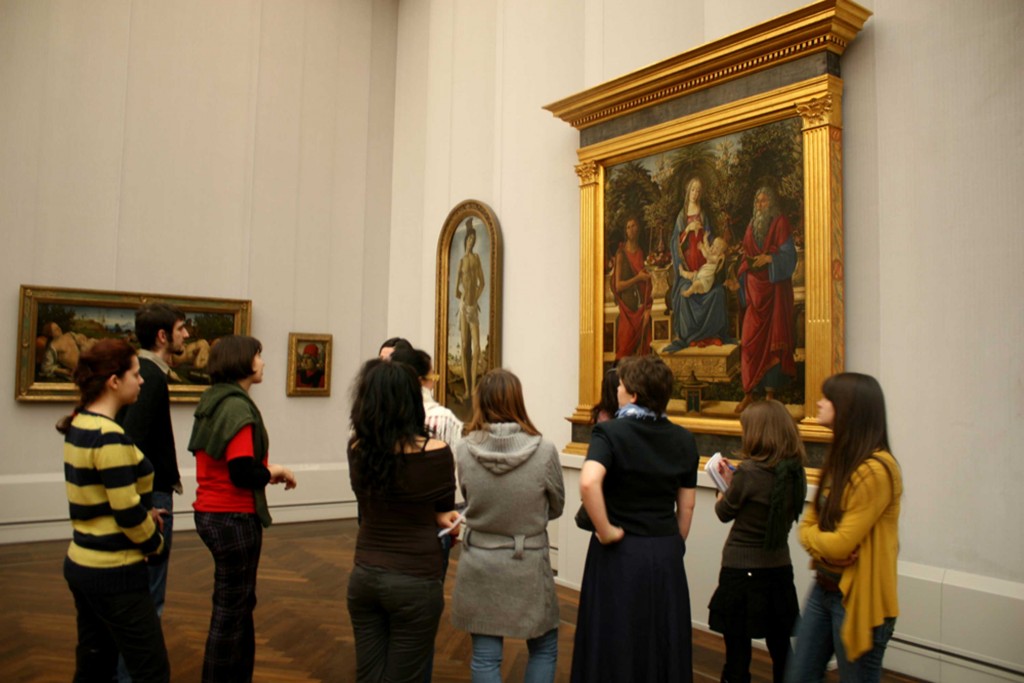
Owing to the immense number of opportunities that Berlin offers, the students of the AY core course managed to get a first-hand experience of some well-known art works that have been the subject of study for the past few weeks. Another of the AY core seminars, led by Professor Aya Soika on February 14, was held in Berlin’s Gemaeldegalerie, famous for housing one of the best collections of European art from the 13th to the 18th centuries. What made it suitable for our visit was the fact that one of its main sections is dedicated to Italian painting from the 13th to the 16th century.
The Gemaeldegalerie was first opened in 1830. The present-day building, however, was built in 1997. The architectural style tries to create a setting in which the paintings will be shown in their true splendor. A special attention is paid to light, which comes from the big windows on the ceiling, and there is even a “piazza” inside – a huge space where no paintings are exhibited and where visitors can just walk, enjoying the freedom that this spacious hall offers.
Aya opened the seminar by showing how a connection has been made between Giotto di Bodone and Mark Rothko. Three paintings, two by Giotto (Crucifixion and Death of the Virgin) and one by Rothko (Reds), were exhibited in a small, cube-like room. The fact that only a limited number of people could enter the room at once created an atmosphere of serenity similar to that of a church. This was done with the intention of giving the viewer time and space to contemplate the art presented. As Rothko himself had said: “silence is so accurate.”
This artistic, and at the same time, highly spiritual, experience was continued by looking at works by Masaccio, Fra Angelico, Piero della Francesca and Piero del Pollaiuolo. These painters are each eminent in a different way: for their manner of arranging space, for the complexity of their compositions, for the use of depictions of shadows in water. Piero del Pollaiuolo’s painting, Annunciation, employs a highly religious theme as an occasion for the innovative presentation of an interior and of space, one that demonstrates the painter’s knowledge of the rules of perspective. An analysis of some of Botticelli’s paintings followed Pollaiuolo: San Sebastian, Madonna and Child with eight Angels and Venus. The students took a particular interest in discussing the way in which Botticelli presented women’s bodies, the proportions that he used, and the notion of beauty in his time. Venus was the painting that attracted the most attention: some students said that although its proportions were not perfect, it still managed to be beautiful and enchanting. This compositional effectiveness was exactly what made Botticelli a genius.
The voyage through the Renaissance ended with a Rubens’ painting – his portrayal of San Sebastian. Students compared this version with Botticelli’s and discussed the differences, as well as the reasons for depicting this very famous theme in such a different manner. Botticelli’s painting was probably his first painting of a male nude body; he portrays it as weaker, less muscular, than does Rubens. Botticelli painted the ascetic saint: one that only cares for the life of the soul, who has retreated into a life of the mind, paying no attention to nature and the physical world. Rubens, on the other hand, gave “life” to the saint’s body; made it more solid and endowed it with physical beauty, making it sensual even in its suffering. Both paintings had an impact on the time in which they were painted and even now serve as a proof of how art changed through history.
By Elena Volkanovska (2009, Macedonia)
